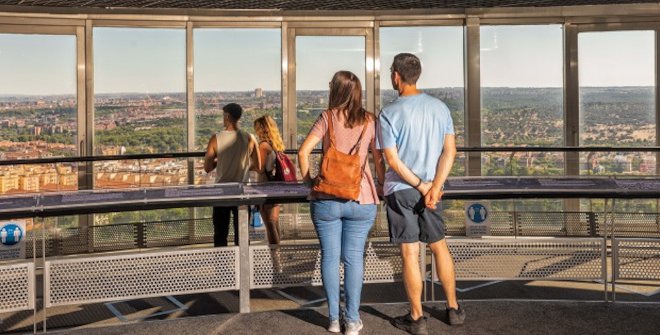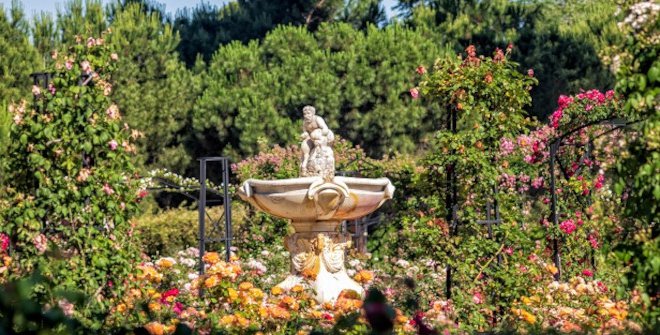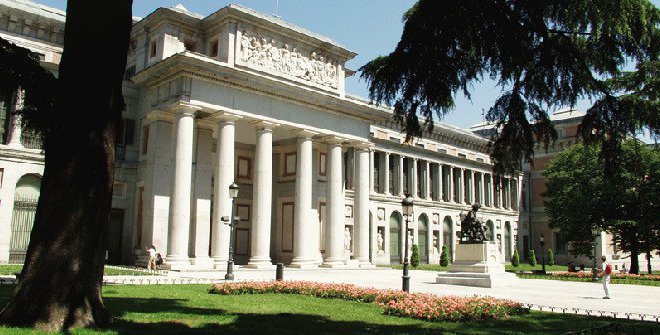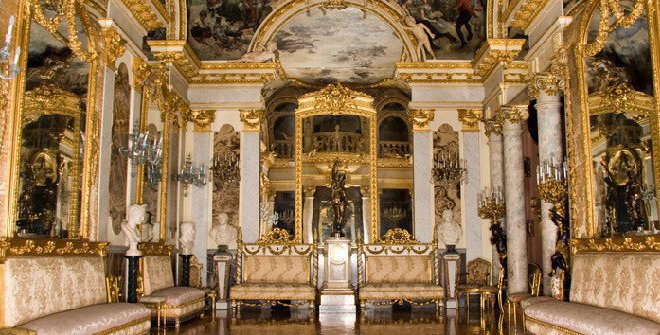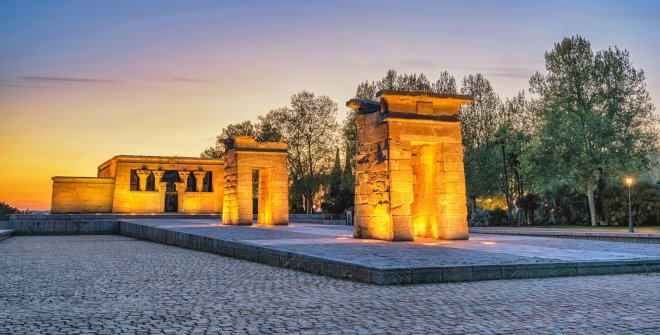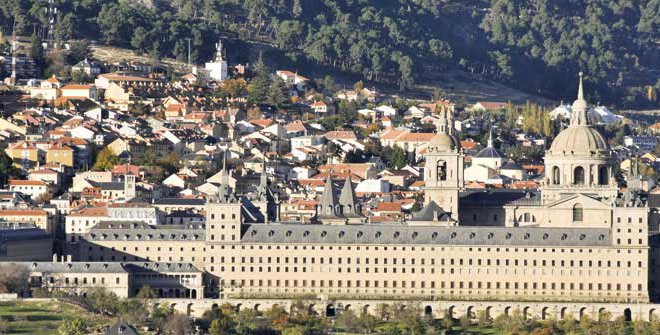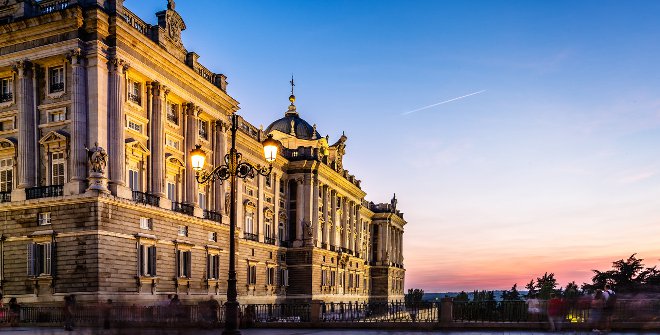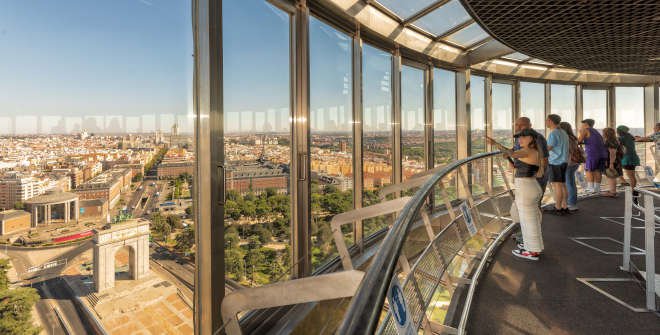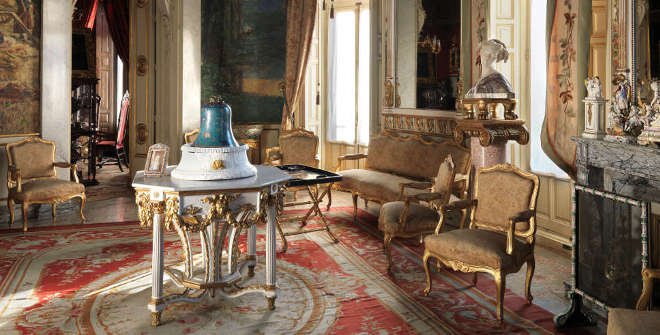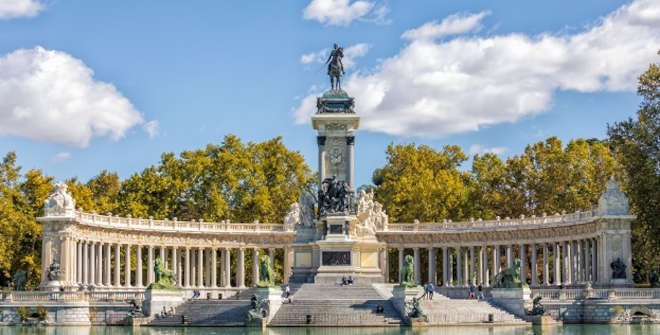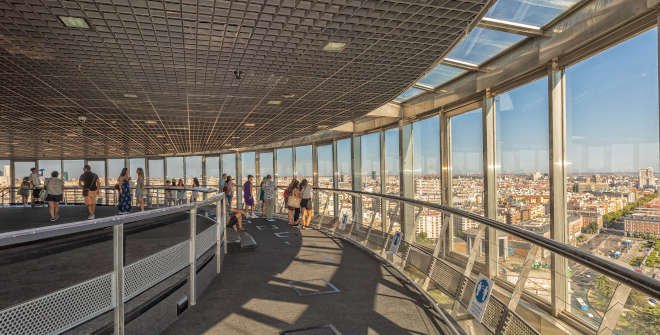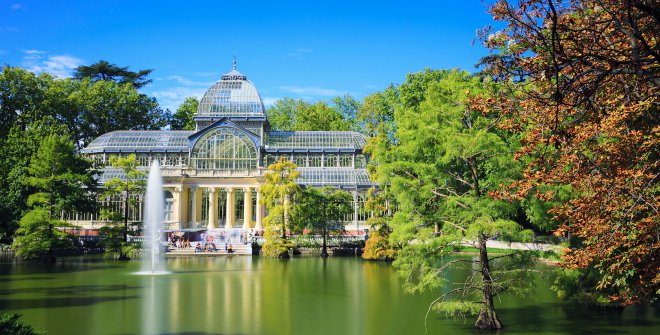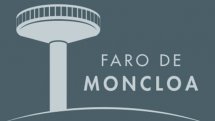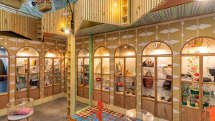Madrid’s seafront promenade
If Madrid had a beach, it would be in Oeste Park. A vast horizon can be seen from Paseo del Pintor Rosales avenue, with Casa de Campo Park resembling a sea of trees and the Sierra de Guadarrama—which can be seen despite being 70 kilometres away—the islands of an imaginary archipelago. We can also add that the Faro de Moncloa is perched on a cape, to avoid boats from running aground on the reefs around the Argüelles neighbourhood.
In this article, we will talk about some of the landmarks of Madrid's best façade: modernist buildings, Belle Époque palaces and some of the first residential towers, built in the 1950s. The sunsets are always spectacular, but it is also worth going there in the daytime to visit its museums, get lost in the coolness of its gardens and enjoy its terraces.
Casa Gallardo (Ferraz, 2)
The modernist style tiptoed through Madrid, so there are hardly any examples of this type of architecture on the city's streets. However, Casa Gallardo, located on the corner of Plaza de España and Calle de Ferraz, sums up all the features of this movement: curved chamfers and decorative plant motifs. This building designed by the architect from Catalonia, Federico de Arias Rey, could be in one of the blocks in Barcelona's Ensanche. Just below the tower, there is a huge golden G, in allusion to the Gallardo family who were behind its construction.

Cerralbo Museum (Ventura Rodríguez, 17)
Running water and the telephone came to this palace before most of the buildings in the neighbourhood. Surrounded by works by El Greco, Zurbarán and Alonso Cano, this was home to Enrique de Aguilera y Gamboa, the Marquis of Cerralbo. Today it is a museum that houses his collection. It has the special feature that everything is still in exactly the same place, as if time has stood still in these rooms, the most sumptuous of the Belle Époque. We can imagine guests getting out of their carriages and then ascending the monumental staircase to the gallery. It is obvious that the sea was too far away, but the mountains can be seen from its windows. Cerralbo Museum can be visited from Tuesday to Saturday from 9.30am to 3pm. On Sundays, it opens half an hour later and on Thursdays, it also opens in the afternoon, from 5pm to 8pm.

Temple of Debod (Ferraz, 1)
Madrid's oldest building is much older than the city itself. It dates back to the 2nd century BC and was brought stone by stone from the other side of the Mediterranean. This story begins with the construction of the Aswan Dam. As a sign of gratitude for the help given to the study and preservation of the archaeological remains, the Egyptian President Nasser decided to donate some of the assets that would be flooded by the waters of the Nile to countries with which Egypt had a good relationship. It was a Pharaonic undertaking, if ever there was one. Since 1975 the centuries-old walls of the Temple of Debod have risen up in Montaña Park. Inside it is covered with beautiful hieroglyphs. It is the perfect place to escape the heat and it can be visited from Tuesday to Sunday, from 10am to 8pm.

Montaña Park
The Madrid executions of 3 May, which Goya immortalised in one of his best-known paintings, took place on this hill that rises up above the valley of the Manzanares. Later, a barracks was built on this same mountain of Príncipe Pío, where Spanish patriots had been condemned to death for rebelling against the power of Joseph Bonaparte. After the Civil War, it was left in ruins, dismantled and replaced by the Temple of Debod surrounded by a garden. From here, it is possible to make out the Royal Palace, Almudena Cathedral, Vistillas, San Francisco el Grande, San Isidro Cemetery, the Latina and Carabanchel neighbourhoods - with the Palacio de Vistalegre-, Casa de Campo, Pozuelo and Aravaca.

Monument to La Chata (Paseo del Pintor Rosales, 5)
Daughter of Queen Isabel II, sister of King Alfonso XII and aunt of King Alfonso XIII, the Isabella of Bourbon was one of the most charismatic people on Madrid’s social scene in the early 20th century. As she was in ill health in 1931, the government of the Second Republic allowed her to continue living in Spain, but she preferred to go into exile along with the rest of her family. She never missed the pilgrimage of Saint Isidro de la Pradera and was often seen in the traditional parties and at the bulls, so she was popularly known as La Chata. Apparently, she loved this nickname. The monument is the work of the architect, Javier García-Lomas Mata and the sculptor, Gerardo Zaragiza.
Pintor Rosales (Paseo del Pintor Rosales, 48)
This walk that goes from the Western Park to the Argüelles neighbourhood is named after the famous painter, Eduardo Rosales. Born in Madrid in 1836, he created some of the paintings that can be seen in the Prado Museum. His most famous paintings include Queen Isabella the Catholic dictating her Will. The monument by Mateo Inurria shows him holding his palette and paintbrush. It was opened in 1922, the same year that the artist died.

The Rose Garden (Calle de la Rosaleda, s/n)
Created in 1955, it hosts the “Villa de Madrid” International New Roses Competition every year in May. The beauty, aroma and originality of each flower is rewarded. In 2006, it was recognised for its excellence and was awarded a prize by the World Federation of Rose Societies. Among its flowerbeds the rose is truly more than just a rose, to paraphrase the North American poet, Gertrud Stein. Here, a rose can be as small as a fingertip or as big as a grapefruit. The names are delightful: now carpet or candy cover.
Juan de Villanueva Fountain (Paseo de Camoens, s/n)
This spectacular 21-metre high fountain has recently been restored. It is so tall that it can be seen through the trees of the Western Park, which was the city’s largest dump until the early 20th century. By means of this monument, the architects, Víctor d’Ors, Manuel Ambrós Escanellas and Joaquín Núñez Mera, and the sculptor, Santiago Costa, sought to pay tribute to Juan de Villanueva, who designed the Prado Museum and the Royal Observatory of Madrid. Since it was unveiled in 1952, it has been a landmark for those who get lost in this steep area of the city.
Cuartel General del Ejército del Aire y del Espacio (Princesa, 87)
Although the sea is far away, the sky is closer than anywhere else. Following what seems to be an overhead walkway that appears to hang from the western end of the city, let’s go to this magnificent building by Luis Gutiérrez Soto. -Prior to the Civil War, the architect was considered to be one of the most avant-garde, with projects such as the Museo Chicote cocktail bar, the Callao cinema or the Barceló cinema, but he designed this building in 1943, inspired by the Royal Monastery of El Escorial. The General Barracks of the Air Force forms a monumental ensemble with the Moncloa-Aravaca Municipal Council building and the Moncloa Arch.

Museum of the Americas (Avda. Reyes Católicos, 6)
As if it were one of the Franciscan missions on the other side of the Atlantic, the Museum of the Americas is located in a colonial-inspired building. The courtyard, the staircase and the neo-baroque tower are all by Luis Moya Blanco. Its collection of pre-Columbian and colonial artefacts is one of the most extensive in Europe. Its many treasures include the Mochica ceramics, the Tre-Cortesian codex - a Mayan codex that is unique in the world - or the portrait of the chiefs of Esmeraldas, which shows three free Afro-descendants. It can be visited from Tuesday to Saturday from 9.30am to 3pm. On Sundays, it opens half an hour later and on Thursdays, it also opens in the afternoon, until 7pm.

Faro de Moncloa (Avenida de la Memoria, 2)
The panoramic lift takes visitors up 92 metres to the great Faro de Moncloa viewpoint. The number is no coincidence. It was built in 1992, the same year that Madrid was named European Capital of Culture and which commemorated the 500th anniversary of Columbus' first voyage to America. Far from reminding us of the admiral's caravels, the design by architect Salvador Pérez Arroyo is futuristic. It offers almost 360º views of the University City, the city of Madrid and the Sierra de Guadarama. On clear days, El Escorial and Gredos can be seen. Those with good eyesight and a lot of imagination may even see the sea.

